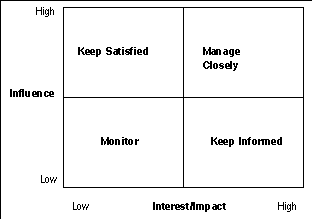|
Supplying Principles and Practices > USPS Supplying Practices Process Step 1: Identify Needs > Identify Key Stakeholders
Identify Key Stakeholders
Stakeholders are individuals or groups that are affected by, or able to
influence, the supply chain management (SCM) business practices
employed.
It is imperative that the key stakeholders are identified during the preliminary
stages of the purchase process. Stakeholder opinions and attitudes are
formulated in the Conceptualize Need task of Process Step 1: Identify
Needs. It is important to collect and assess the interests of all stakeholders,
who may represent different Client groups, and to resolve conflicting needs.
Failure to identify key stakeholders early in the supply process can create
additional risks to the success of the project.
The first step in identifying key stakeholders is to brainstorm. Consider
everyone affected by the supply decision, those who have influence or power
over it, and those who have an interest in its outcome. One of the best ways
to identify stakeholders is to plot them on an Influence/Impact Matrix. The
next step is to prioritize stakeholders by influence and impact and to plot this
on an Influence/Impact Matrix (illustrated below). The final step is to
understand what motivates the stakeholders and how to gain their confidence
with the eventual results.
After identifying the key stakeholders, perform a stakeholder-mapping
exercise, using the Influence/Impact Matrix illustrated in Figure 1.3.
Figure 1.3
Influence/Impact Matrix for Stakeholder Prioritization

Classify key stakeholders by the extent to which they can influence the
project and the degree to which it will/may affect them. A stakeholder's
position on the grid illustrates particular actions that may be taken when
interacting with him or her:
• High-influence, high-impact individuals: significant efforts should
be made to satisfy this group.
• High-influence, low-impact individuals: Effort should be made to
keep this group satisfied, but on a more limited basis than the
high-impact group.
• Low-influence, high-impact individuals: This group is adequately
informed, and close communication is stressed to ensure that
major issues are addressed.
• Low-influence, low-impact individuals: Monitor members of this
group for consideration and consultation.
Stakeholder Analysis will be critical in communicating with key stakeholders
throughout the project life cycle. It will also be the foundation for developing
the communication plan, which is discussed in the Prepare Project task of
Process Step 2: Evaluate Sources.
|
